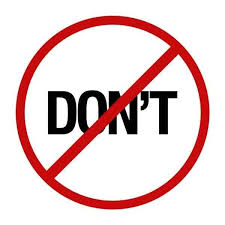As a sport psychologist, there are times when I would consider myself a “language specialist.” A lot of times, actually, when I stop and count them all up. This is because language, how we talk to ourselves and others, has a huge impact on our lives. Language – AKA “thinking” – influences our choices, our emotions, our ability to respond to stress, really, everything. And so it is with great persistence that I help athletes become more aware of how they are thinking, how they are talking to themselves. And when it’s appropriate, we make some changes!
My favorite time to make a self-talk or language adjustment is for what I lovingly call “Don’t Statements.” You’re probably really familiar with Don’t Statements, but just never thought to categorize and call them by such a label. For instance,
“Don’t freak out.”
“Don’t get distracted.”
“Don’t get gassed.”
Is it hard to see what the problem is with this way of talking and thinking? If you guessed “it’s negative” you’re partly there. But in full disclosure, I don’t put a lot of emphasis on someone being “positive” or less negative. There are extensive reasons why I think a constant focus on being positive may not be useful all the time. For another blog, another time. Pinkie swears.
The full answer, I believe, starts with realizing that our language is a reflection of what tends to take up the most space in our minds. And as a general rule, people are really good at focusing on what seems scary, unwanted. And paradoxically, we end up reinforcing these uncomfortable possibilities by talking and thinking about them more.
Want a super easy demonstration of this?
Don’t think about a red balloon.
.
.
.
.
.
.
Crap. What just happened? Yeah, telling yourself to not think something actually puts that thought at the forefront of your mind. So it would appear that Don’t Statements just don’t work. At least not in way that gets rid of the unwanted thought.
Additionally problematic is that these statements are often thought (or shouted at the athlete) during a time of intense practice or important competition. They don’t provide a lick of useful information. Why would you want to do that? When it really counts, you need to make use of every moment available to you. Don’t Statements are ineffective AND inefficient. When it really matters, athletes need to be thinking (and coaches need to be shouting) something that gives guidance, a helpful reminder, something to get/keep that athlete on track.
Working from the statements listed above, you could change them (and there’s lots of options, these are just a suggestion) to:
“Use the relaxation skills you’ve been practicing.”
“Focus on your task in the moment.”
“Trust yourself to make smart decisions about how you expend your energy.”
Ok, they can be a *bit* wordier. Use a cue word to shorten it up if necessary. And they force you to really think, really focus on what you want, which may not be the first thing that comes to mind. That’s where effort comes in.
While it isn’t complicated, it IS tricky to undo years of talking and thinking a certain way. And even when you fix your Don’t Statements, you still need to work on helping those around you change their’s. It won’t happen overnight and it will require intentional effort. But if you’re going to be thinking anyway, why not think in a way that stands to benefit you? I promise, it gets easier with practice! Plus, with all that journaling you’re doing you might be able to record some of your favorite Don’t Statements and more quickly recognize them the next time they come up. Nice!
Remember: frame your self talk in terms of what you DO want to see happen, instead of what you want to avoid.



